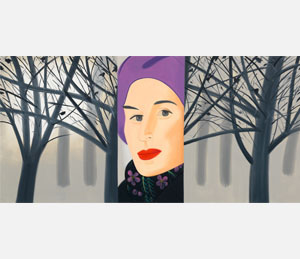
January 3
January 3, 1993, 1993
Oil on linen, 199.4 x 393.7 cm
Courtesy Timothy Taylor Gallery, London
© VEGAP, Bilbao, 2015
“I think the big change came in 1957 when I started to paint Ada over and over again. I'd splash around with paint and see if I could get the expression in the eyes right and that kind of thing. It always seemed a big gag to me. When I started doing it, I couldn't get a likeness and I couldn't get the expression in the eyes right. I had to break down the whole open style of painting at that point. And I figured . . . well, if I get Ada right, if you only get one person right—if you get a woman or a man right—it's universal. So what the hell." (1)
INTRODUCTION
Alex Katz (b. 1927, Brooklyn, New York) was already a well-known artist when he met Ada Del Moro at the opening of one of his exhibitions in 1957. Del Moro was a research biologist who traveled and studied in Europe. They had an instant connection, and a year later they were married. With her as his model, muse, and mate, Katz began to concentrate on specific portraiture, and for the first time he started to enlarge the size and scale of his paintings. He developed a bold new portraiture style, combing realism and abstraction by placing his sitter frontally, depicting them in a realistic style on an abstract and monochromatic background (2).
From the beginning of their relationship Ada served as his partner in exploring new avenues in modern portraiture. Katz paints her from life, not from photographs. She appears repeatedly in his paintings, in various poses, with different attributes, and in different settings. She is alone, repeated, with friends, showing different personalities, posing in the fashions of the time. Katz works quickly, starting with a fast sketch, usually on a panel with oil paint, and later transfers his painting to a large canvas. His goal is to capture the blast of perception that happens when we first see something (3). If he were to go into the painting over and over, reworking it, he’d lose that sense of immediacy (4).
January 3 exemplifies his technique. Painted in 1993, it is a combination of his approaches to landscape and portraiture. In the center of the painting is a cropped portrait of Ada, flanked by a misty winter wooded scene. He first made a sketch of his idea en plein air, and later moved to his studio and created a large-scale artwork in a single five-hour sitting (a process captured in a film by Katz’s son, Vincent, and daughter-in-law, Vivien Bittencourt).
Katz recounts his process: “It started in the movies. I was at Film Forum, and they were showing a Russian movie. People walking down an alley with trees around them. I thought it would be a great image for a winter painting. So I went down to city hall and painted it outdoors. It was a cold winter day and the air was kind of a little heavy, so the sun was trying to come through. I painted that en plein air. I liked the image a lot, so I asked Ada to come down and I did a sketch. I started with a relatively small landscape, and then I think I did the large one because it seemed like something that would go large successfully. I just thought I’d try the split. It just seemed like it would be an interesting idea.” (5).
1. http://www.aaa.si.edu/collections/interviews/oral-history-interview-alex-katz-12448
2. Jill Berk Jiminez et Joanna Banham, Dictionary of Artists' Models (Chicago: Fitzroy Dearborn Publishers, 2001), p. 291.
3. http://www.vogue.com/13275846/alex-katz-high-museum-january-3-artsplainer
4. Ibid.
5. Ibid.
Preguntas
Show: January 3, 1993 (1993)
What’s going on in this painting? What do you notice about the setting? Where do you think she is?
Look closely at the character in this painting. What can you infer about this person based on her facial expression? How do you think she is feeling? What might she be thinking? What do you see that makes you say that?
Her eyes seem to be looking directly at the viewer. If you were to start a conversation with her, what would you ask her? How would the dialogue go?
At first glance, Katz’s painting might appear to be a triptych, but it is one canvas divided into three areas. Upon closer inspection, the painting’s components come together as a whole. How does he unify the three sections?
Katz begins a painting by sketching his idea on a small panel. Then he transfers the sketch onto a large canvas, drawing directly on it. He paints quickly, frequently finishing a painting in one session. During the five hours it took to complete this 199.4 x 393.7 cm painting January 3, 1993, Katz’s son Vincent and his daughter-in-law Vivien Bittencourt filmed the process. The video is without dialogue. You can watch a portion: http://www.films.com/ecTitleDetail.aspx?TitleID=19314&r=. What did you learn about how Katz works? Discuss what you found interesting or surprising.
